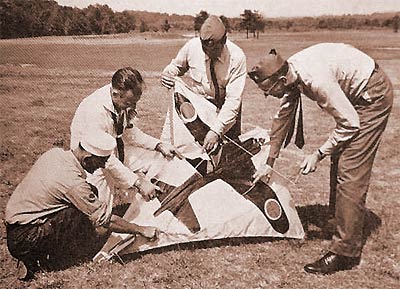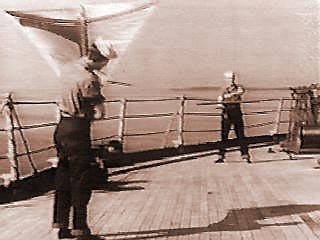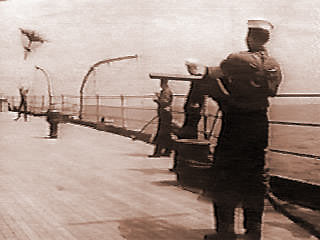| Target
Kite Mk.1,2 Extract of Manual : Manoeuvres |
DESCRIPTION GENERALE | |
| MATERIELS |
| Wokipi-Kite |
|
FLYING
|
| It
is obvious that a kite requires wind. An ordinary kite needs only
enough for support, but this target kite most have sufficient additional
pressure to hold the flying lines rigid so that response to control
will be prompt. The Mark I kite needs at least 10 knots. The wind should be steady and smooth. Very strong winds increase the speed of the kite, but reduce its arc of lateral swing. Whenever possible, select a large open area without vertical obstructions. Hills, trees and buildings cause turbulence which interferes with proper maneuvering. However, an experienced operator will learn to overcome many of these difficulties by taking full advantage of the unique controllability of the target kite, and may even make use of disturbed air currents to assist the flight of the kite. |
|
|
|
THEORY
|
| To understand
the behavior and handling of this kite, it will be helpful to know
the reasons for its design and action. It is inherently stable. Longitudinally,
a keel surface is formed by the wind pressing the fabric each side
of the mast. The fin at the bottom increases the keel surface and
aids in keeping the kite erect. Its lateral stability is due to the
bowing of the spar, which forms a dihedral angle like that found in
many airplanes designed with their wings rising from center. The bridle forms a V-shaped attachment with its apex connected to the flying lines and its two base points connected to the masts, proportioned so that the center of gravity, the center of pressure, and the center of thrust are in proper relationship. The bridle together with the keel and dihedral gives the kite three-dimensional stability. The most important objective governing the use of this kite as a target is to give good service to the gunners. This requires efficient functioning of the kite crew, adequate equipment, and proper conditions. |
 |
|
|
|
KITE
CREW
|
| An officer
and six men comprise a good working group. At least three of the men
should be skilled operators; the others should understand assembly,
adjustment, assistance in launching, and repair. Duties of the kite officer shall be: to insure the safety of his men, that none venture into the area of fire; to direct their smooth operation as a team, having supervised their training and selected the best as operators; to give the gunners speedy service in maintaining a target aloft with others in reserve; to maintain contact by phone or signal with the firing line; and to keep equipment in readiness. |
|
|
|
USE
AT SEA, ABOARD SHIP
|
 |
The
maneuverable target kite is particularly adaptable for use at sea Winds over water are usually of adequate velocity, but if not, sufficient pressure is often created against the kite by the ship's movement. When steering a zig-zag path the kite can be flown on alternate quarters to give practice to the port and starboard gunners If the prevailing wind is a following one, nullified by the ship's speed, when it is impractical to lay-to or change course for firing practice, another vessel can tow kites past the others. Precautions : The place for launchings should be as far as possible from fittings, gear and overhead rigging, which might obstruct the take-off. The launching assistant should be located at least thirty feet leeward so that the initial rise of the kite can be well aloft. When the kite aloft becomes disabled by a well-aimed hit, every effort should be made to |
| reel
it back aboard so as to salvage parts and so that hits can be counted.
If it falls into the water with the ship under way, retrieving may
be impossible due to the greatly increased drag of the kite in the
water. In small ships particularly, the roll and pitch, together with the pull of the kite, require that the operator be secured to the deck with safety straps. These are hooked to his belt and attached to deck fittings at a backward angle on each side so that he will feel their security as he leans forward and can devote his attention to the kite instead of having to worry about his own footing. Instructions : It is assumed that the operator has learned to fly the kite in one of the several schools established ashore, where conditions are much more adaptable to easier take-offs and salvaging of crashes than at sea. One who has learned to fly the kite, however, can instruct others at sea, using the instruction stick or the tandem-teaching methods. Operations : The maneuvering of the kite, organization of the kite crew, firing and scoring will be similar to corresponding actions ashore, with innovations and improvements in accord with the type of ship and intentions of the gunnery officer. |
 |